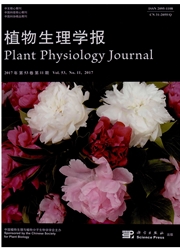

 中文摘要:
中文摘要:
植物生长发育过程中会合成大量萜类化合物,其中多数具有挥发性。这些挥发性萜类成分除参与保护光合器官免受光合作用产生的热量灼伤之外,还作为信号分子参与了大量的化学生态过程,例如对昆虫和其他动物的吸引以利于花粉和种子的传播。另一方面,自上世纪80年代以来,逐渐有研究工作表明,挥发性萜类化合物也可以作为信号介导植物对植食性昆虫的防御反应,以及在植物.害虫.天敌的三级营养关系中发挥作用。同时,研究工作还显示萜类化合物可以作为信号在同株植物的不同部位之间及邻近植物之间进行有效传递以促进对虫害的防御,并证明了这些萜类分子在细胞和分子水平上的调控作用。这些工作为利用化学生态学手段对虫害进行有效控制提供了新的策略。文章仅就近年来对植物萜类挥发信号分子在合成、识别、传输及其作用等方面的研究进展做简要回顾。
 英文摘要:
英文摘要:
Plants synthesize and emit a large amount of terpenoid constituents during their growth and development. Most terpenoids are volatile. Their emission functions not only in the protection of photosynthetic organelles against overheating, but also in the chemical ecological processes, e.g. the attraction of insects and other animals for the dispersal of seeds and pollens. However, from the 1980s, accumulative evidences showed that plants could use volatile terpenoids in their defensive responses against herbivore insects, and also use them to mediate tritrophic nutritional interactions among plants, herbivores and natural enemies. Other work also proved that volatile terpenoids could carry signals from attacked plant to other plants nearby. It has been deciphered step by step that volatile terpenoids could regulate plant activities at both cellular and molecular levels, and this provides a feasible strategy for effective pest control by chemical ecological methods. The progresses in the biosynthesis, transportation, recognition and functions of volatile terloenoids are summarized here.
 同期刊论文项目
同期刊论文项目
 同项目期刊论文
同项目期刊论文
 Synthesis, biological evaluation, 3D-QSAR studies of novel aryl-2H-pyrazole derivatives as telomeras
Synthesis, biological evaluation, 3D-QSAR studies of novel aryl-2H-pyrazole derivatives as telomeras Identification and characterization of microRNAs in the crab- eating macaque (Macaca fascicularis) u
Identification and characterization of microRNAs in the crab- eating macaque (Macaca fascicularis) u Design, synthesis and antibacterial activity studies of thiazole derivatives as potent ecKAS III inh
Design, synthesis and antibacterial activity studies of thiazole derivatives as potent ecKAS III inh Serum microRNAs profile from genom-wide serves as a fingerprint for diagnosis of acute myocardial in
Serum microRNAs profile from genom-wide serves as a fingerprint for diagnosis of acute myocardial in Synthesis, biological evaluation, and molecular docking studies of novel 1,3,4-oxadiazole derivative
Synthesis, biological evaluation, and molecular docking studies of novel 1,3,4-oxadiazole derivative Application of an Endophytic Bacillus amyloliquefaciens CC09 in Field Control of Rehmannia glutinosa
Application of an Endophytic Bacillus amyloliquefaciens CC09 in Field Control of Rehmannia glutinosa Ultrasensitive detection of lead ion based on target induced assembly of DNAzyme modified gold nanop
Ultrasensitive detection of lead ion based on target induced assembly of DNAzyme modified gold nanop Mitochondrial Inhibitor Sensitizes Non-Small-Cell Lung Carcinoma Cells to TRAIL-Induced Apoptosis by
Mitochondrial Inhibitor Sensitizes Non-Small-Cell Lung Carcinoma Cells to TRAIL-Induced Apoptosis by Molecular Docking Explores the Possible Binding mode for Potential Inhibitors of Thioredoxin Glutath
Molecular Docking Explores the Possible Binding mode for Potential Inhibitors of Thioredoxin Glutath Quercetin and allopurinol reduce liver thioredoxin-interacting protein to alleviate inflammation and
Quercetin and allopurinol reduce liver thioredoxin-interacting protein to alleviate inflammation and Vaticaf?nol, a resveratrol tetramer, exerts more preferable immunosuppressive activity than its prec
Vaticaf?nol, a resveratrol tetramer, exerts more preferable immunosuppressive activity than its prec Design, modi?cation and 3D QSAR studies of novel naphthalin-containing pyrazoline derivatives with/w
Design, modi?cation and 3D QSAR studies of novel naphthalin-containing pyrazoline derivatives with/w Synthesis, biological evaluation and molecular modeling studies of Schiff bases derived from 4-methy
Synthesis, biological evaluation and molecular modeling studies of Schiff bases derived from 4-methy Betaine recovers hypothalamic neural injury by inhibiting astrogliosis and inflammation in fructose-
Betaine recovers hypothalamic neural injury by inhibiting astrogliosis and inflammation in fructose- Twoconserved oligosaccharyltransferase catalytic subunits required forN-glycosylation exist in Spart
Twoconserved oligosaccharyltransferase catalytic subunits required forN-glycosylation exist in Spart Cloning of novel rice blast resistance genes from two rapidly evolvingNBS-LRR gene families in rice.
Cloning of novel rice blast resistance genes from two rapidly evolvingNBS-LRR gene families in rice. Widely distributed hot and cold spots in meiotic recombination as shown by sequencing of rice F2 pla
Widely distributed hot and cold spots in meiotic recombination as shown by sequencing of rice F2 pla Reactive oxygen species-induced TXNIP drives fructose-mediated hepatic inflammation and lipid accumu
Reactive oxygen species-induced TXNIP drives fructose-mediated hepatic inflammation and lipid accumu Wuling San protects kidneydysfunction by inhibiting renal TLR4/MyD88 signaling and NLRP3 inflammasom
Wuling San protects kidneydysfunction by inhibiting renal TLR4/MyD88 signaling and NLRP3 inflammasom Enhanced charge transfer by gold nanoparticle at DNA modified electrode and its application to label
Enhanced charge transfer by gold nanoparticle at DNA modified electrode and its application to label Widely distributed hot and cold spots in meiotic recombination as shown by the sequencing of rice F-
Widely distributed hot and cold spots in meiotic recombination as shown by the sequencing of rice F- Bacterial community structure in cooling water and biofilm in an industrial recirculating cooling wa
Bacterial community structure in cooling water and biofilm in an industrial recirculating cooling wa Desertification dynamic and the relative roles of climate change and human activities in desertifica
Desertification dynamic and the relative roles of climate change and human activities in desertifica Design, synthesis andbiological evaluation of novel pyrazolinecontaining derivatives as potentialtub
Design, synthesis andbiological evaluation of novel pyrazolinecontaining derivatives as potentialtub Dihydropyrazoles containingmorpholine: design, synthesis and bioassay testing aspotent antimicrobial
Dihydropyrazoles containingmorpholine: design, synthesis and bioassay testing aspotent antimicrobial Sulfonamide derivativescontaining dihydropyrazole moieties selectively and potently inhibitMMP-2/MMP
Sulfonamide derivativescontaining dihydropyrazole moieties selectively and potently inhibitMMP-2/MMP Simple electrochemicalsensing of attomolar protein using fabricated complexes with enhanced surfaceb
Simple electrochemicalsensing of attomolar protein using fabricated complexes with enhanced surfaceb Mitochondrial InhibitorSensitizes Non-Small-Cell Lung Carcinoma Cells to TRAIL-Induced Apoptosis byR
Mitochondrial InhibitorSensitizes Non-Small-Cell Lung Carcinoma Cells to TRAIL-Induced Apoptosis byR The evolution of soybeanmosaic virus: An updated analysis by obtaining 18 new genomic sequences ofCh
The evolution of soybeanmosaic virus: An updated analysis by obtaining 18 new genomic sequences ofCh Pterostilbene and allopurinol reduce fructose-induced podocyte oxidative stress and inflammation via
Pterostilbene and allopurinol reduce fructose-induced podocyte oxidative stress and inflammation via EGFR/HER-2 inhibitors:synthesis, biological evaluation and 3D-QSAR analysisof dihydropyridine-contai
EGFR/HER-2 inhibitors:synthesis, biological evaluation and 3D-QSAR analysisof dihydropyridine-contai Design, synthesis,biological evaluation and molecular modeling of dihydropyrazole sulfonamidederivat
Design, synthesis,biological evaluation and molecular modeling of dihydropyrazole sulfonamidederivat Interaction of photoperiod and temperature in the development of conchocelis of Porphyra purpurea (R
Interaction of photoperiod and temperature in the development of conchocelis of Porphyra purpurea (R 期刊信息
期刊信息
